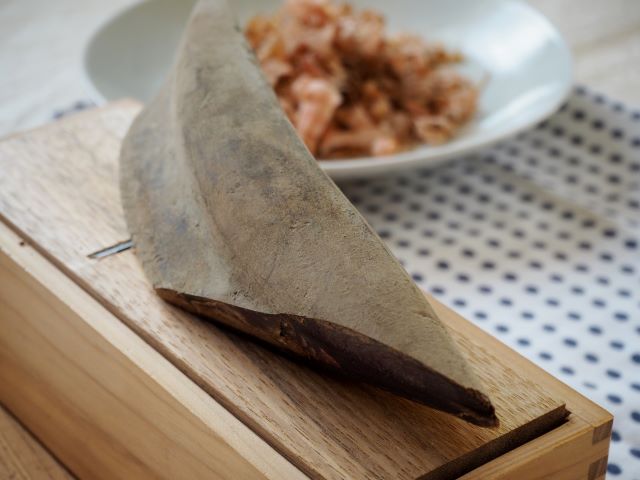
Katsuobushi (鰹節) appears frequently in documents from the Muromachi period (1333-1573) and later, and was used then, as it is now, to take dashi. The name Tosa-bushi is also found in documents from the early Edo period (1603-1868), but the method of making it seems to have been to boil it down and then dry it in the sun, and it is said that the current molding method was invented around 1673~81. In the Tosa Domain, which has been famous for bonito fishing since ancient times, Harimaya Sanosuke of Usa and Yamazaki Giemon of Nakahama worked to improve and popularize Tosa-bushi, and the name Tosa-bushi spread as a specialty of the domain in Edo and Osaka.
The process of making katsuobushi begins by boiling the formed bonito meat in boiling water, removing the bones and some of the skin, placing it in baskets, and then placing it in a chamber to be heated and dried over a fire made of oak, sawtooth oak, or kashiwa (oak tree). This is called Baikan (焙乾).
At this stage the product to be shipped is called Namabushi. The first Baikan is called Ichiban-bi. After that, the cracks and missing parts of the Fushi are repaired with bonito surimi. The baikan is repeated once a day for 2 to 12 times. In case you are wondering, Katsuobushi before shaving is called Fushi.
After Baikan, it is called Arabushi (荒節) or Onibushi (鬼節). After drying in the sun for a few days, the surface is scraped with a small knife and called Hadakabushi (裸節), Akamuki (赤むき), Wakabushi (若節), Shinbushi (新節), etc. After drying in the sun again, it is placed in a wooden box called Kabi-tsuke-bako for 15 to 17 days in a cool and dark place, and the surface of the Fushi is covered with blue-green mold. This initial molding is called Ichiban-kabi (一番黴). This process is repeated, and those that have been processed for Niban-kabi are called Aokarebushi (青枯れ節).
This process is usually repeated four times, and when the Yoban-kabi (四番黴) process is completed, the product is called Hongarebushi (本枯れ節). This process is very effective in reducing the fishy smell and fat content of the Fushi and improving its flavor and color.
The best Katsuobushi is the one that is well-dried, has a tortoiseshell-like color, and a clear metallic sound when tapped. When buying katsuobushi with high-fat content or oxidized fat, the surface color may be white or yellowish-brown, so care should be taken when purchasing katsuobushi.
Kezuribushi made by shaving Hongarebushi is called Katsuobushi-kezuri (鰹節削り). On the other hand, shaved Arabushi is called Katsuo-kezuri (鰹削り). Katsuobushi-kezuri has a milder fragrance than Katsuo-kezuri and is relatively light. This is because the mold softens the smoky smell of Baikan and the fishy smell of fish.
Generally, Arabushi is used mainly in Kansai, while Hongarebushi is preferred in Kanto. The reason for this goes back to the Edo period (1603-1867). At that time, Katsuobushi was transported to Edo by sea from western Japan, including Tosa, Satsuma, and Kishu. However, because mold grew during the voyage, it was dried in the sun and eaten, which added a mild aroma. Since then, mold-dried Katsuobushi has been favored in Edo.
Kezuribushi varies in thickness. Usukezuri (薄削り) is 0.1 mm or less and is used as Hana-katsuo (花かつお) for decoration, and is not suitable for making dashi. Nakakezuri (中削り) is around 0.2 mm thick and is generally used at home because it can be used to make dashi in a short period of time. Atsukezuri (厚削り) is about 0.7 mm thick and should be boiled for about 20 minutes to make dashi. Atsukezuri is rarely used by itself but is often blended with several types of Fushi for commercial use.
Kezuribushi is all about the aroma. To prevent volatilization and oxidation of the aroma, it should be sealed in a plastic bag, with the air inside pushed out, and stored in a refrigerator or freezer. Even though it is dry food, it needs to be handled in the same way as fresh food.
What are the aromatic components of katsuobushi?
Katsuobushi is said to be the hardest food in the world, yet it is often used in thinly shaved form. It is primarily used in dashi and furikake to enhance umami and aroma. The aroma of katsuobushi is generated during the manufacturing process through smoking and mold cultivation. The aroma increases during the baikan (dry-roasting process), and ketones such as acetone and 2-butane, aromatic hydrocarbons such as benzene and toluene, furans such as 2-methylfuran, pyrazines such as dimethylpyrazine, and phenols such as phenol and guaiacol have been identified. Many of these seem to originate from the components of the smoke used in the dry-roasting process.
[sc_apply url=”https://sushiuniversity.jp/apply/”]
We hope this information will be helpful.

Revision date: September 17, 2025
Share this article
I love how Katsuobushi flakes dance on top of hot food. It’s such a small detail but it makes the whole plate feel alive, almost like a little performance before you eat.